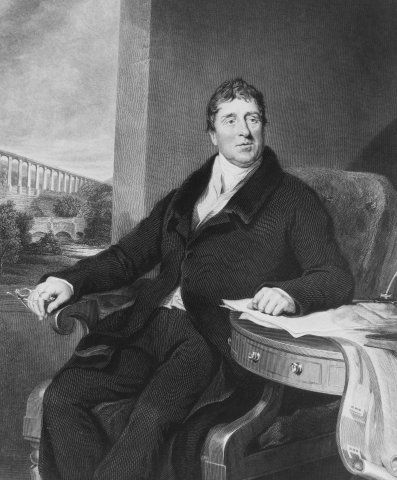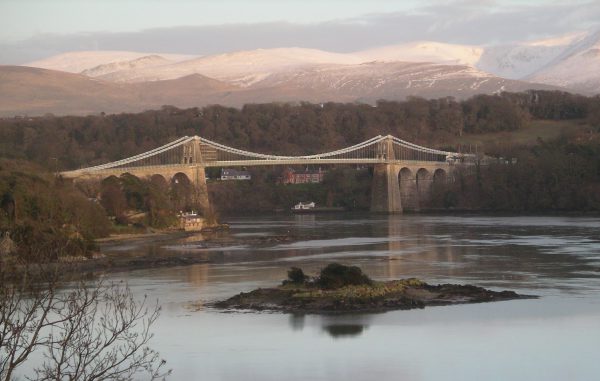
Thomas Telford (1757-1834)
On August 9, 1757, Scottish civil engineer, architect and stonemason Thomas Telford was born. After establishing himself as an engineer of road and canal projects in Shropshire, he designed numerous infrastructure projects in his native Scotland, as well as harbors and tunnels. Such was his reputation as a prolific designer of highways and related bridges, he was dubbed The Colossus of Roads (a pun on the Colossus of Rhodes), and, reflecting his command of all types of civil engineering in the early 19th century, he was elected as the first President of the Institution of Civil Engineers.
A Self-Tought Engineer
Thomas Telford was born at Glendinning, a hill farm east of Eskdalemuir Kirk, in the rural parish of Westerkirk, in Eskdale, Dumfriesshire, in a remote Scottish valley close to the English border, to John Telford, a shepherd, who died soon after Thomas was born. Thomas was raised in poverty by his mother Janet Jackson. At the age of 14 he was apprenticed to a stonemason. He worked for a time in Edinburgh and in 1782 he moved to London where, after meeting architects Robert Adam and Sir William Chambers, he was involved in building additions to Somerset House there. Two years later he found work at Portsmouth dockyard and — although still largely self-taught — was extending his talents to the specification, design and management of building projects. In 1787, through his wealthy patron William Pulteney, he became Surveyor of Public Works in Shropshire, a post that entailed the construction of buildings and bridges. Civil engineering was a discipline still in its infancy, so Telford was set on establishing himself as an architect. His projects included renovation of Shrewsbury Castle, the town’s prison, as well as some churches.
Bridges and Canals
In 1790 he designed a bridge carrying the London–Holyhead road over the River Severn at Montford, the first of some 40 bridges he built in Shropshire, including major crossings of the Severn at Buildwas, and Bridgnorth. The bridge at Buildwas was Telford’s first iron bridge. This bridge was an engineering marvel, and it helped make his reputation as one of the greatest civil engineers in Britain.[4] In 1793 Telford became agent and engineer to the Ellesmere Canal Company. His two great aqueducts, which carry this canal over the Ceiriog and Dee valleys in Wales at Chirk and Pontcysyllte (Pont Cysylltau), employed a novel use of troughs of cast-iron plates fixed in the masonry. These brought him national fame.[1] The same period also saw Telford involved in the design and construction of the Shrewsbury Canal. When the original engineer, Josiah Clowes, died in 1795, Telford succeeded him. One of Telford’s achievements on this project was the design of the cast-iron aqueduct at Longdon-on-Tern, pre-dating that at Pontcysyllte, and substantially bigger than the UK’s first cast-iron aqueduct, built by Benjamin Outram on the Derby Canal just months earlier.[5] The Ellesmere Canal was completed in 1805 and alongside his canal responsibilities, Telford’s reputation as a civil engineer meant he was constantly consulted on numerous other projects. These included water supply works for Liverpool, improvements to London’s docklands and the rebuilding of London Bridge.

Menai Suspension Bridge
Consulting the Swedish King
His success led to a government appointment to survey the roads in rural Scotland as part of a major transportation improvement scheme. His survey results were accepted and Telford was asked to oversee the construction of some 1,000 miles of roads and 120 bridges – a job which took him over 20 years to complete.[3] Telford was consulted in 1806 by the King of Sweden about the construction of a canal between Gothenburg and Stockholm. His plans were adopted and construction of the Göta Canal began in 1810. Telford travelled to Sweden at that time to oversee some of the more important initial excavations.
More Roads, Bridges, and Canals
Telford was also involved in road construction. He came up with the idea of ensuring water drainage by means of a bulge in the middle of the road. In addition, he dealt with the optimal design of roads with regard to the lines and the cross section of the road. Together with John Loudon McAdam, he is regarded as one of the fathers of modern road construction. During his later years, Telford was responsible for rebuilding sections of the London to Holyhead road, a task completed by his assistant of ten years, John MacNeill. On the island of Anglesey a new embankment across the Stanley Sands to Holyhead was constructed, but the crossing of the Menai Strait was the most formidable challenge, overcome by the Menai Suspension Bridge (1819–26). Spanning 180 m, this was the longest suspension bridge of the time. His use of the cast iron arch bridge at Craigellachie in Scotland and the Waterloo Bridge in Wales turned structure into a form of art.[3]
The Colossus of Roads
Thomas Telford founded the Institution of Civil Engineers in London in 1818, and today around 80,000 civil engineers in 140 countries belong to it. The punning nickname Colossus of Roads was given to Telford by his friend, the eventual Poet Laureate, Robert Southey. In 1821, he was elected a foreign member of the Royal Swedish Academy of Sciences. In 1820, Telford was appointed the first President of the recently formed Institution of Civil Engineers, a post he held until his death on September 2, 1834, in London.
Stephen Brindle, James Sutherland History Lecture 2020: Where does civil and structural engineering come from? [6]
References and Further Reading:
- [1] Thomas Telford, Scottish engineer, at Britannica Online
- [2] Ian Jack: Man of Iron: Thomas Telford and the Building of Britain by Julian Glover review – the colossus of roads, The Guardian, January 19, 2017
- [3] David Ross: Thomas Telford biography, at Britain Express
- [4] Thomas Telford, at History
- [5] Benjamin Outram an the First Cast Iron Navigable Aqueduct, SciHi Blog
- [6] Stephen Brindle, James Sutherland History Lecture 2020: Where does civil and structural engineering come from?, The Institution of Structural Engineers @ youtube
- [7] . Encyclopædia Britannica (11th ed.). 1911.
- [8] “Colossus of Roads?”. Feature on Telford’s testament. National Archives of Scotland. 2007.
- [9] Thomas Telford at Wikidata
- [10] Map with architectural structures designed by Thomas Telford





